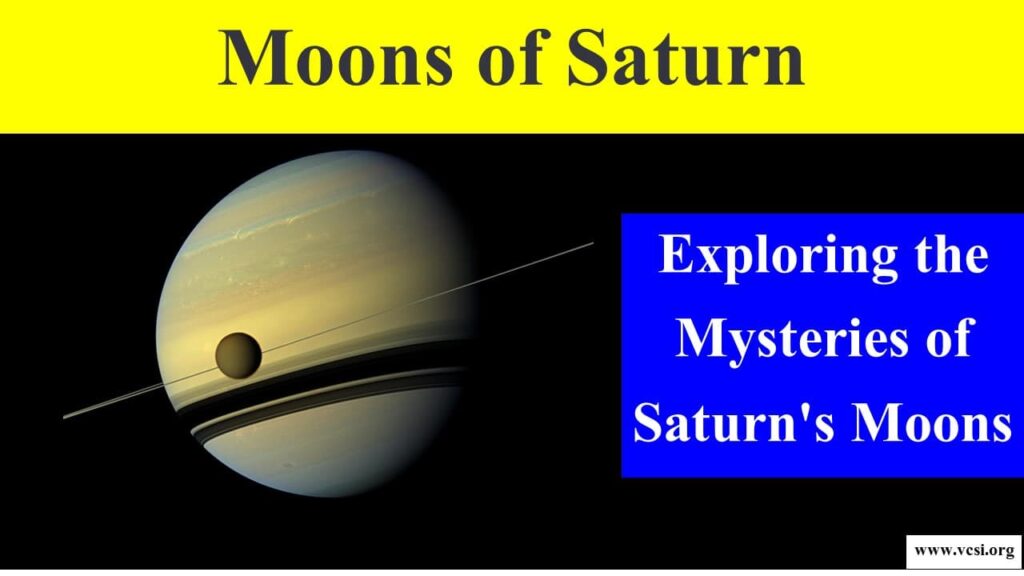Moons of Saturn: Exploring the Mysteries of Saturn’s Moons, Discover the intriguing world of Saturn’s moons, names, characteristics, exciting discoveries. wonders of the Moons of Saturn, Planet, How many, by Size
Saturn, the sixth planet from the Sun and the second-largest in our solar system, boasts a captivating collection of moons. These celestial bodies, known as the Moons of Saturn, have fascinated astronomers and space enthusiasts for centuries. In this article, we will explore the secrets of these enigmatic satellites, including their names, features, and remarkable discoveries made by various space missions. Join us as we embark on an interstellar adventure to uncover the mysteries of Saturn’s moons.

Moons of Saturn: A Celestial Ensemble
Saturn’s moons form a diverse and fascinating group, each possessing unique characteristics and intriguing mysteries. Let’s take a closer look at some of the prominent moons that grace the Saturnian system.
Titan: The Giant Among Moons
Titan, the largest moon of Saturn and the second-largest moon in the entire solar system, is a celestial marvel. It boasts a dense atmosphere enveloped in a thick haze of nitrogen and methane. Scientists have made astonishing discoveries on Titan, such as the presence of lakes, rivers, and even rain on its surface. These findings have sparked immense interest in further exploration of this extraordinary moon.
Enceladus: The Icy Fountain of Life?
Enceladus is a captivating moon that showcases remarkable geologic activity. It harbors a subsurface ocean of liquid water, which periodically erupts from cracks in its icy shell, creating magnificent geysers that propel water vapor and ice particles into space. The presence of these geysers has ignited scientific curiosity and raised the possibility of finding signs of life beyond Earth.
Iapetus: The Yin-Yang Moon
Iapetus presents a mesmerizing appearance with its distinct two-toned surface resembling the yin-yang symbol. One hemisphere of this moon showcases a dark, heavily cratered terrain, while the other boasts a bright, icy landscape. Scientists speculate that the dark side of Iapetus may have acquired its color from debris ejected by distant moons or other celestial objects.
Rhea: The Moon with an Ancient Crater
Rhea, Saturn’s second-largest moon, is home to an intriguing feature known as the “Great Crater.” This colossal impact basin spans approximately one-third of Rhea’s diameter and is believed to have formed billions of years ago. The presence of such a prominent crater raises questions about the cataclysmic events that shaped the early history of Rhea and its neighboring moons.
Conclusion
Saturn’s moons, with their captivating allure and mysteries, have provided scientists and space enthusiasts with a wealth of knowledge and astonishing discoveries. From the intriguing lakes of Titan to the erupting geysers of Enceladus, each moon offers a unique window into the complexity of our solar system. As we continue to unveil the secrets of these enigmatic satellites, the Moons of Saturn beckon us to explore further, igniting our curiosity and inspiring future generations to reach for the stars.
| Home Page | Click Here |
| Telegram Channel | Click Here |
FAQ
Q : How many moons does Saturn have?
Ans : Saturn is known to have at least 82 moons orbiting around it, and future discoveries may uncover even more.
Q : Do all the moons of Saturn have official names?
Ans : Not all of Saturn’s moons have been formally named. Some smaller moons are referred to by provisional designations until they are officially named.
Q : Which moon is the smallest among Saturn’s moons?
Ans : Methone holds the title of the smallest known moon of Saturn, with a diameter of approximately 3 kilometers (1.9 miles).
Q : Have any space missions explored Saturn’s moons?
Ans : Yes, several space missions, including the Cassini-Huygens mission, have provided valuable insights into the Moons of Saturn, revolutionizing our understanding of these distant worlds.
Q : Is there evidence of volcanic activity on Saturn’s moons?
Ans : Yes, volcanic activity has been observed on certain moons of Saturn, such as Enceladus and Titan, where cryovolcanism occurs involving water and other volatile substances.
Q : Can Saturn’s moons potentially support human colonization?
Ans : While some moons possess intriguing features that could potentially support future human exploration, extensive research and technological advancements would be required to make colonization a reality.
Other Links –